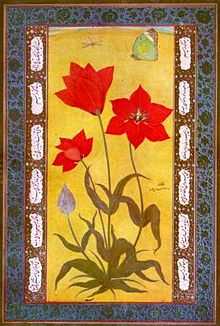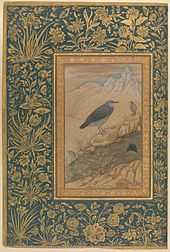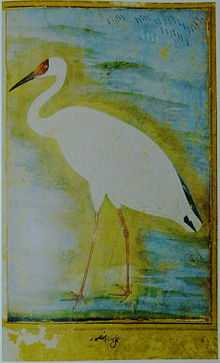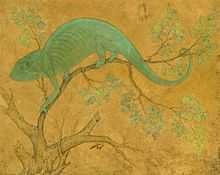Ustad Mansur

Ustad Mansur (flourished 1590-1624) was a seventeenth-century Mughal painter and court artist. He grew in acclaim during the reign of Jehangir (r. 1605 - 1627) during which period he excelled at depicting plants and animals. He was the earliest artist to depict the Dodo in colour, apart from being the first to illustrate the Siberian Crane. Towards the end of Akbar's reign, he gained the prefix of ustad (=master) and during the reign of Mughal Emperor Jahangir his masterpieces earned him the title of Nãdir-al-’Asr ("Unequalled of the age"). While many of Mansur's paintings bear his signatures, some were copied by others and these works are widely dispersed around the world in museum and private collections.[1][2]
Life and work

The year of Mansur's birth is unknown. His name was suffixed in some early miniatures as Naqqash (which can refer to an artist, painter, carver) which indicates that he came from a family that was in an artistic profession.[3] A single miniature showing 'Babur meeting his sister' (folio 8, National Museum) is attributed to Mansur but he otherwise finds no mention in the Baburnama (1598).[4] He was associated with other artists of the period including Basawan, Miskina and Nanha. During Akbar's reign he appears to have been involved only as a colorist in the plates for the Akbarnama and his name is not mentioned by Abu'l-Fazl among the list of artists. Akbar followed the principle that all artwork includes the name of the artist on the margin. The British Museum's copy of the Akbarnama (1604) includes some folios (35,110a,110b and 112a) where his name is prefixed with "ustad" (=master), indicating his rise to excellence.[5]
Early works included parts of portraits and other scenes. The earliest works were made as part of the Baburnama (1590-95) and most of these are as an assistant or a colourist.[6] His Veena-player (c. 1595) and coronation portrait of Jahangir (c. 1605, made along with the artist Manohar) are early works. In 1612, Jehangir received a turkey cock from Goa and this was illustrated by Mansur. In 1619, Jehangir received a falcon (shungar) as a gift from Shah Abbas of Persia. The falcon, identified as a Barbary Falcon (Falco peregrinus babylonicus) was treated carelessly and was mauled by a cat, leading to its death. Jehangir found it rare and beautifully patterned and ordered that a likeness be made of the bird. In 1620, Jehangir visited Kashmir and spotted a Brown Dipper which he described in his memoirs (Tuzhuk-i-Jehangiri) translated as:[7]

"... In this stream I saw a bird like a saj. It dives and remains for a long time underneath and then comes up from a different place. I ordered them to catch and bring two or three of these birds, that I might ascertain whether they were waterfowl and were web-footed, or had open feet like land birds. They caught two... One died immediately and the other lived for a day. Its feet were not webbed like a duck's. I ordered Nadirul-asr Ustad Mansur to draw its likeness" Mansur painted at least one hundred flowers from the Kashmir valley during this period.[8] A red tulip from Kashmir is a better-known painting. The identity of the tulip is however debated with competing suggestions that include Tulipa lanata, T. montana and T. lehmanniana.[9] In 1621, Jehangir was gifted a zebra and this was perhaps the subject of the last miniature painting made by Mansur. It is suggested that his career ended with the reign of Jehangir in 1627.[10] Several other signed works, such as one of the Siberian Crane (now no longer a winter migrant to India) and the other of a Bengal Florican are in the Indian Museum, Kolkata. Some other works are in the National Museum, Delhi, the Maharaja Sawai Man Singh II Museum, Jaipur and the Chhatrapati Sivaji Vastu Sangrahalaya, Mumbai.[11]

Not all of Mansur's birds were based on reality. He also created fantasy birds and many of the compositions such as the flowers and insects in the background are juxtapositions created for effect.[12] It appears that these imaginary birds were made in the style of his senior peers, Miskina and Ikhlas, and were made only early in his career as a artist.[13] In terms of style, Mansur's illustrations focus on detail with a single bird dominating the composition. The birds or animals are in a standing posture or in a feeding stance. He often used plants and insects in the background and the floral borders, characteristic of Mughal works may help in identifying his works.[14]
The most significant paintings, in terms of zoology, are those of the Siberian Crane and the Dodo. The Siberian Crane painting was made well before it was formally described and given a binomial name by Peter Simon Pallas in 1773. The painting of the Dodo is among the rare few that were depicted in colour and is a very important source for zoologists. It is thought that the Dodo was brought to Jehangir's court via Portuguese controlled Goa and the painting of it was discovered in the Hermitage at St. Petersburg and although unsigned has been thought to be the work of Mansur or a close contemporary.[15][16][17] The Siberian Crane painted on paper is extremely detailed showing the wrinkles on the bare skin, the legs and a small feather stuck to the claw. Abanindranath Tagore was taken by E. B. Havell, principal of the art school at Calcutta and shown this painting. On examining the detail through a lens, he was inspired to move away from oil on canvas to gouache on paper.[18]

Ustad Mansur was not the only artist in the Mughal court to illustrate flora and fauna. Other artists included Abu'l Hasan, Farrukh Beg, govardhan, Inayat, Manohar, Muhammad Nadir, Murad and Pidarath. Jehangir considered Mansur and Abu'l Hasan to be exceptional artists.[19] Abu'l Hasan was given the titled of Nadir uz Zaman.[20] Several later 17th-19th century artists have come to both imitate and copy his works (sometimes with his signature[21]), especially for export to Europe. It is therefor not easy to asses a true work by Ustad Mansur, which can in case of the chameleon (above left) had to be done by taking in account the quality of the work. The painting is highly detailed and is presumed to be an Indian chameleon on account of the highly detailed view of the feet of the animal showing each foot exhibiting "fused digits in opposed groups", a lighter band by the edge of the mouth, and a line of white scales on the underside of the belly.[2]
A crater on the planet Mercury is named in honour of Mansur.[22]
Notes
- ↑ Blunt, Wilfrid (1948). "The Mughal Painters of Natural History". The Burlington Magazine 90 (539): 48–50.
- ↑ 2.0 2.1 http://www.royalcollection.org.uk/collection/912081/a-chameleon
- ↑ Verma (1999):42
- ↑ Verma (1999):43
- ↑ Verma (1999):43
- ↑ Verma (1999):42.
- ↑ Welch, Stuart Cary, ed. (1987). The Emperors' Album. Images of Mughal India. New York: Metropolitan Museum of Art. p. 172.
- ↑ Verma (1999):25
- ↑ Das (2013):148.
- ↑ Verma (1991):41.
- ↑ Majumdar, R.C. (ed.) (2007). The Mughul Empire, Mumbai: Bharatiya Vidya Bhavan, ISBN 81-7276-407-1, p. 815
- ↑ Das (2013):136.
- ↑ Das (2013):137.
- ↑ Verma (1999):53-55.
- ↑ Das, A.K. 1974. "Ustad Mansur", Lalit Kala 17:32-39.
- ↑ Rangarajan, M. (2001) India's Wildlife History. Permanent Black. pp. 14,19.
- ↑ Iwanow, A (1958). "An Indian picture of the Dodo". Journal of Ornithology 99 (4): 438–440. doi:10.1007/BF01671614.
- ↑ Das (2013):114.
- ↑ Verma (1999):40
- ↑ Verma (1999):25
- ↑ Verma (1999):72.
- ↑ "Gazetteer of Planetary Nomenclature". NASA & USGS. Retrieved 20 January 2014.
References
- Bosworth, CE; E. van Donzel; B. Lewis and C. Pellat, ed. (1988). The Encyclopaedia of Islam. New Edition. Volume 6. Mand-Marashis. Leiden: R. J. Brill. pp. 424–426.
- Das, Asok Kumar (2013). Wonders of Nature. Ustad Mansur at the Mughal Court. Marg Publications.
- Verma, S. P. (1999). Mughal Painter of Flora and Fauna Ustad Mansur. Abhinav Publications.
External links
- The Emperors' album: images of Mughal India, an exhibition catalog from The Metropolitan Museum of Art (fully available online as PDF), which contains material on Ustad Mansur (nos. 41,44,45,47)
- The Royal Collection: A chameleon, contains a larger piece on Ustad Mansur under further details.
- Metropolitan Museum Collections - Nilgai Great Hornbill Vultures
- Victoria and Albert Museum - Cheer Pheasant Zebra Turkey Sketch of two cranes